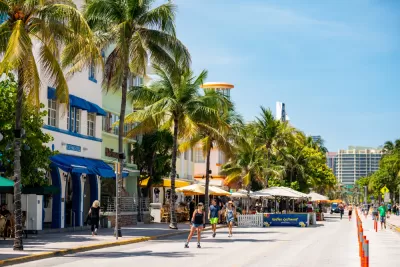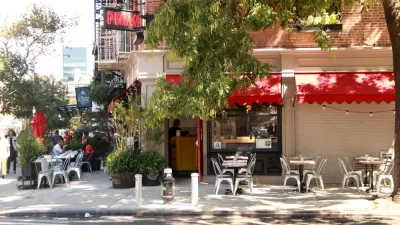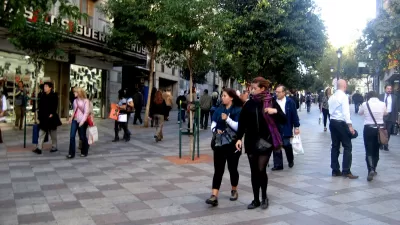The famous cruising strip was off-limits to cars during the pandemic. Now, the city is letting vehicles return with some pedestrian-oriented compromises.

"Like many cities around the world, Miami Beach responded to the Covid-19 crisis by transforming what was once a busy thoroughfare into a car-free space, allowing walkers, bikers and rollerbladers to roam free, and restaurants to expand their outdoor seating offerings." But starting January 24, the city will bring back one-way traffic on a ten-block portion of Ocean Drive, but with some pedestrian-friendly adjustments, reports Sarah Holder. The city is adding two-way bike lanes and keeping one block pedestrian-only.
The transformation of Ocean Drive into a 'slow street' drew both praise and criticism from locals, some of whom expressed the usual complaints about loss of parking and diverted traffic. Yet dire predictions about damage to the strip's vibrant restaurant, nightclub, and luxury car rental industry have not been borne out. In fact, Holder writes, "Resort taxes on food, beverages and room rentals each month of this fiscal year and several months of last have been higher than even pre-pandemic revenues, according to city data published in December 2021." Daniel Ciraldo, executive director of the Miami Design Preservation League, attributes the rise in revenue to the increase in people walking—and noticing businesses—on the street.
As cities begin to dismantle or adapt pandemic-era open streets programs, Miami is developing a long-term plan to prioritize pedestrians on Ocean Drive and the rest of South Beach, increase open space, and allow limited car access to accommodate local needs.
FULL STORY: Miami Beach’s Ocean Drive Revs Up for a Car Comeback

Trump Administration Could Effectively End Housing Voucher Program
Federal officials are eyeing major cuts to the Section 8 program that helps millions of low-income households pay rent.

Planetizen Federal Action Tracker
A weekly monitor of how Trump’s orders and actions are impacting planners and planning in America.

Ken Jennings Launches Transit Web Series
The Jeopardy champ wants you to ride public transit.

Washington Legislature Passes Rent Increase Cap
A bill that caps rent increases at 7 percent plus inflation is headed to the governor’s desk.

From Planning to Action: How LA County Is Rethinking Climate Resilience
Chief Sustainability Officer Rita Kampalath outlines the County’s shift from planning to implementation in its climate resilience efforts, emphasizing cross-departmental coordination, updated recovery strategies, and the need for flexible funding.

New Mexico Aging Department Commits to Helping Seniors Age ‘In Place’ and ‘Autonomously’ in New Draft Plan
As New Mexico’s population of seniors continues to grow, the state’s aging department is proposing expanded initiatives to help seniors maintain their autonomy while also supporting family caregivers.
Urban Design for Planners 1: Software Tools
This six-course series explores essential urban design concepts using open source software and equips planners with the tools they need to participate fully in the urban design process.
Planning for Universal Design
Learn the tools for implementing Universal Design in planning regulations.
Heyer Gruel & Associates PA
Ada County Highway District
Institute for Housing and Urban Development Studies (IHS)
City of Grandview
Harvard GSD Executive Education
Toledo-Lucas County Plan Commissions
Salt Lake City
NYU Wagner Graduate School of Public Service





























